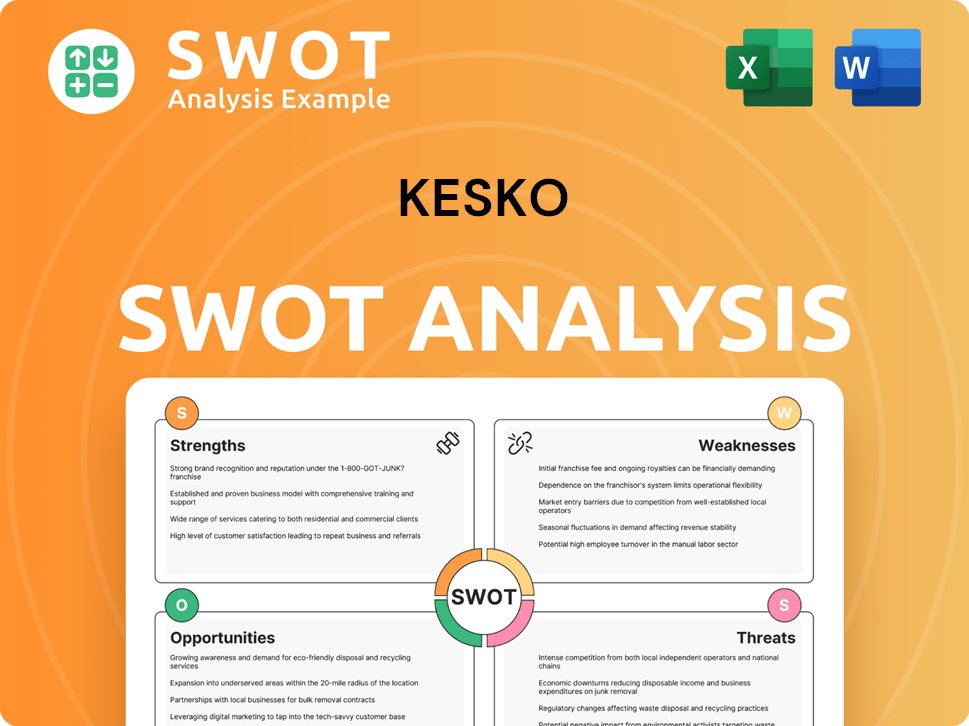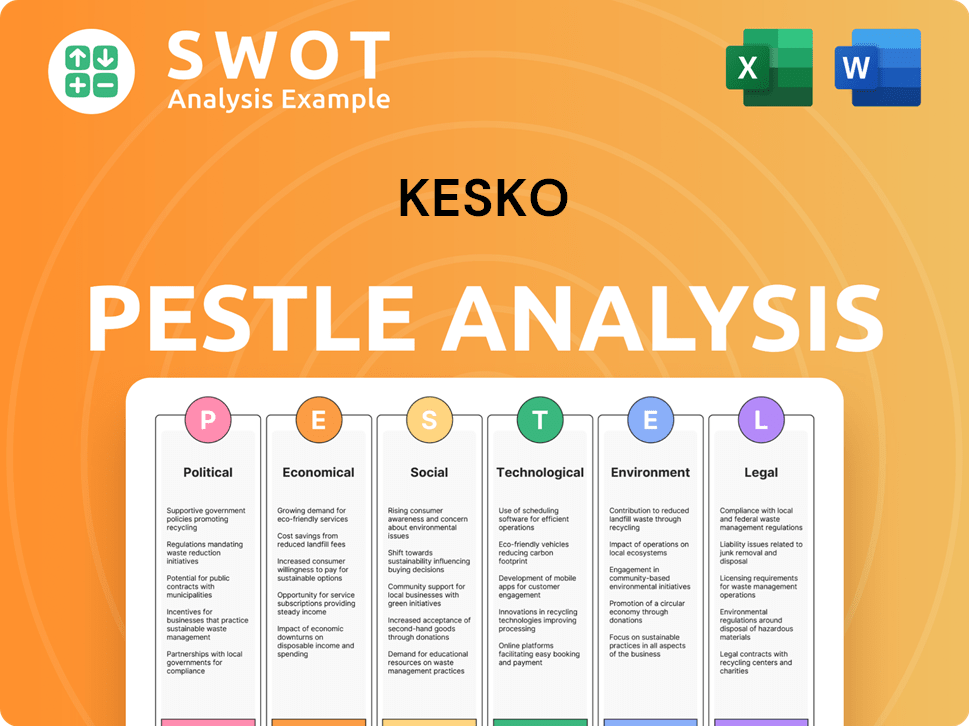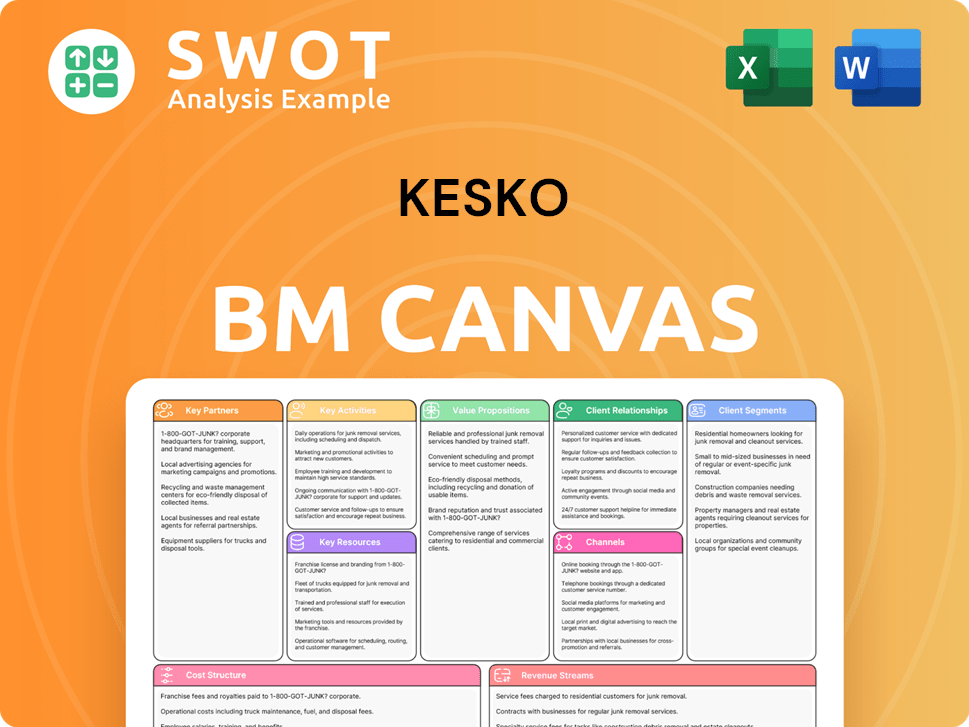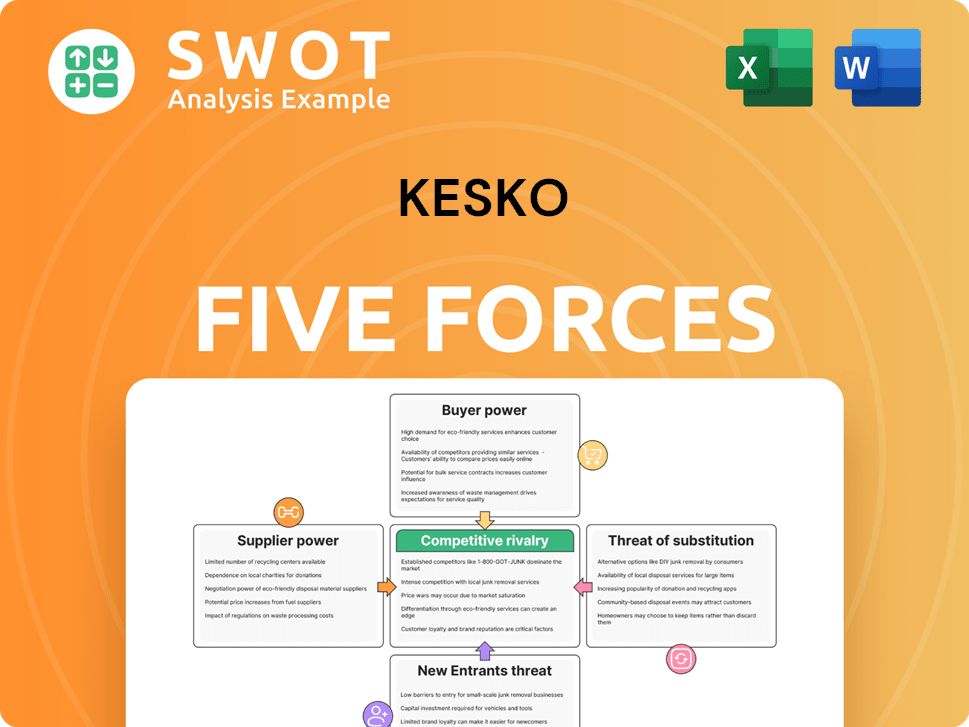Kesko Bundle
Who are Kesko's Customers, and How Does it Adapt?
Embark on a journey to uncover the Kesko SWOT Analysis and the core of Kesko Company's success: its understanding of its customer demographics and target market. From navigating the seismic shifts in consumer behavior during the pandemic to catering to diverse needs across multiple sectors, Kesko's ability to adapt is key. This exploration delves deep into the Finnish retail giant's evolution, offering a comprehensive look at its customer base and strategic responses.

This deep dive into Kesko Company's customer base will provide valuable insights for market analysis and strategic planning. We'll examine the company's customer segmentation, exploring the characteristics of its target audience across grocery, building and home improvement, and car trade sectors. Understanding Kesko's customer demographics, preferences, and acquisition strategies is crucial for any investor or business strategist looking to understand the dynamics of the retail market and the effectiveness of Kesko's
Who Are Kesko’s Main Customers?
Understanding the Revenue Streams & Business Model of Kesko involves a deep dive into its primary customer segments. The company strategically targets diverse groups across its grocery, building and technical, and car trade divisions. This approach allows it to capture a broad market share and cater to various consumer needs and preferences.
The Kesko company serves both business-to-consumer (B2C) and business-to-business (B2B) customers. Its operations are designed to meet the demands of both individual consumers and corporate clients. This dual focus is a key aspect of its market strategy, ensuring a wide reach and diversified revenue streams. This strategy has proven successful, with the company continually adapting to changing market dynamics and consumer behaviors.
The target market for Kesko is segmented across its different business areas. Grocery trade focuses on B2C customers through various store formats and online platforms. The building and technical trade serves both B2C and B2B clients, while the car trade primarily targets B2C customers. This segmentation allows Kesko to tailor its products and services to specific customer needs.
The grocery trade primarily serves B2C customers through its K-Citymarket, K-Supermarket, K-Market, and K-Ruoka online stores. These stores cater to a wide range of customer demographics, from families to individuals. The online platform, K-Ruoka, targets digitally-savvy consumers seeking convenience.
In the building and technical trade, Kesko serves both B2C and B2B customers through K-Rauta and Onninen. B2C customers include homeowners, while B2B customers consist of construction companies and professional builders. The B2B segment, particularly through Onninen, is a significant revenue driver.
The car trade segment, mainly through K-Auto, serves B2C customers for new and used car sales, as well as B2B customers for fleet sales and maintenance. This segment often targets middle to high-income individuals and businesses. This segment has seen consistent performance, reflecting stable demand.
Kesko has increased its focus on digital services and sustainability. The company has invested in e-commerce capabilities across all divisions to meet the growing preference for online shopping. This shift is a response to changing consumer behaviors and market trends.
Kesko's key customer groups include families, individuals, construction companies, professional builders, and businesses requiring transportation solutions. The company's strategy is designed to cater to a wide array of customer needs. This approach has allowed Kesko to maintain a strong market position and adapt to changing market dynamics.
- Families seeking everyday groceries and household items.
- Individuals looking for convenient meal solutions.
- Construction companies and professional builders.
- Businesses requiring reliable transportation solutions.
- Digitally-savvy consumers who prioritize convenience.
Kesko SWOT Analysis
- Complete SWOT Breakdown
- Fully Customizable
- Editable in Excel & Word
- Professional Formatting
- Investor-Ready Format

What Do Kesko’s Customers Want?
Understanding the customer needs and preferences is crucial for the success of the Kesko company. This involves a deep dive into the customer demographics and the specific demands of its diverse target markets. By analyzing these factors, Kesko can tailor its offerings and strategies to meet and exceed customer expectations.
Kesko's approach to understanding its customers is multifaceted, encompassing market research, customer feedback, and sales data analysis. This allows the company to identify key trends and adapt its business models to changing consumer behaviors. The company's ability to cater to various segments, from grocery shoppers to construction professionals, is a testament to its customer-centric focus.
The Kesko strategy is designed to address the varied needs of its customer base across different sectors. This includes providing high-quality products, excellent customer service, and innovative solutions. Through continuous adaptation and a strong understanding of its target markets, Kesko aims to maintain its competitive edge and foster customer loyalty.
Grocery customers of Kesko prioritize convenience, quality, and competitive pricing. They often shop weekly and increasingly prefer online ordering and home delivery. Kesko focuses on product availability and store proximity to meet these needs.
B2C customers in the building and technical trade seek practical solutions for home improvement, emphasizing product durability and ease of use. B2B customers prioritize reliability, comprehensive product ranges, and competitive bulk pricing. Kesko addresses these needs with tailored product offerings and services.
Customers in the car trade seek reliability, safety, and fuel efficiency, with a growing interest in electric and hybrid vehicles. Kesko tailors its marketing to promote these features and offers. Brand reputation and technological advancements also influence customer decisions.
Kesko utilizes loyalty programs like K-Plussa to provide tailored benefits and discounts, influencing repeat purchases. Personalized offers and a pleasant shopping experience are key to fostering loyalty. This approach is central to the Kesko strategy.
Feedback from customer surveys and market trends continually influence product development. Kesko adapts by expanding its eco-labeled product offerings and plant-based food options. This responsiveness ensures alignment with evolving consumer demands.
Kesko segments customer data to provide relevant offers, such as promoting seasonal produce to grocery shoppers. This targeted approach enhances the customer experience and drives sales. This strategy is part of Kesko's overall customer-centric approach.
Kesko's ability to understand and respond to customer needs is crucial for its market position. The company's focus on customer satisfaction is a core component of its business model. For more details, see Growth Strategy of Kesko.
- K-Plussa Loyalty Program: With millions of members, this program offers tailored benefits and discounts, driving repeat purchases.
- Eco-Labeled Products: Expanding offerings to meet the growing demand for sustainable and energy-efficient solutions.
- Online Ordering and Home Delivery: Enhancing convenience for grocery customers, particularly accelerated by recent events.
- Data-Driven Marketing: Segmenting customer data to provide relevant offers and improve the customer experience.
Kesko PESTLE Analysis
- Covers All 6 PESTLE Categories
- No Research Needed – Save Hours of Work
- Built by Experts, Trusted by Consultants
- Instant Download, Ready to Use
- 100% Editable, Fully Customizable

Where does Kesko operate?
The geographical market presence of Kesko is primarily focused on Northern Europe. The company strategically operates within Finland, Sweden, Norway, Estonia, Latvia, Lithuania, and Poland. Its operations are tailored to the specific demographics and preferences of each region, ensuring a localized approach to its business activities.
Finland serves as Kesko's home market and a significant stronghold. The company holds a leading market share in the grocery trade and a strong position in the building and technical trade within the country. Kesko's strategy involves adapting its product offerings and marketing efforts to resonate with local cultures and regulations.
Kesko's international presence is growing, particularly in the building and technical trade. The company has expanded its operations across the Nordics and the Baltics, with key markets in Sweden and Norway. This expansion is supported by strategic partnerships and a focus on serving both consumer and B2B customers.
Finland is the core market for Kesko, where it has a strong presence in both grocery and building/technical trade. In 2023, the grocery trade sales in Finland showed robust performance. K-Rauta operates in Finland, Sweden, Norway, and Estonia, contributing significantly to the building and technical trade.
Sweden and Norway are important markets for Kesko, especially for its Onninen operations, which serve B2B customers. These markets are crucial for the building and technical trade segment. The car trade, primarily through K-Auto, is concentrated in Finland, representing a significant portion of the Finnish car market.
Kesko also has a presence in Estonia, Latvia, Lithuania, and Poland, with Onninen operating in these regions. The company adapts its product assortments and marketing campaigns to suit local tastes and regulations. This geographic diversification supports Kesko's overall market strategy.
Differences in customer demographics and preferences are considered across regions. For example, the demand for sustainable and organic products may vary. Kesko localizes its offerings and marketing strategies to succeed in diverse markets, including adapting product assortments and partnering with local suppliers.
Kesko's market strategy involves continuous optimization of its store network and online presence. Recent strategic expansions focus on strengthening its position in the building and technical trade in Northern Europe. The geographic distribution of sales indicates a strong reliance on Finnish operations, complemented by growing contributions from international segments. For a detailed analysis of Kesko's financials, the company's annual reports provide comprehensive data.
- Customer demographics are key to Kesko's market approach.
- The target market is primarily Northern Europe.
- Kesko adapts its strategies to local market conditions.
- Building and technical trade is a focus for expansion.
Kesko Business Model Canvas
- Complete 9-Block Business Model Canvas
- Effortlessly Communicate Your Business Strategy
- Investor-Ready BMC Format
- 100% Editable and Customizable
- Clear and Structured Layout

How Does Kesko Win & Keep Customers?
The company employs a comprehensive approach to customer acquisition and retention, utilizing both traditional and digital marketing channels. Their strategies are tailored to the diverse business areas, ensuring a broad reach across various customer segments. This multi-faceted approach is crucial for maintaining a strong market presence and fostering customer loyalty.
For customer acquisition, the company invests heavily in advertising campaigns across various media, including television, radio, print, and digital platforms. Digital platforms, such as social media and search engine marketing, are increasingly important for reaching specific demographics. Promotional pricing and seasonal campaigns also play a key role in attracting new customers. The company also focuses on building strong customer relationships through its loyalty program, personalized experiences, and robust after-sales service.
Customer retention is a key focus, with the company leveraging its K-Plussa loyalty program, one of the largest in Finland. This program offers personalized discounts and exclusive promotions, which helps in understanding customer behavior and tailoring future offers. They also prioritize personalized customer experiences, utilizing data to provide relevant recommendations. This data-driven approach allows for more effective marketing campaigns and improved customer satisfaction, ultimately aiming to reduce churn rates and increase customer lifetime value.
The company utilizes extensive advertising campaigns across various channels including television, radio, print media, and digital platforms. Digital marketing efforts include social media, search engine marketing (SEM), and display advertising. Influencer marketing is also used to reach specific demographic segments, particularly in the grocery and home improvement sectors.
The K-Plussa loyalty program is central to customer retention, offering personalized discounts and exclusive promotions. This program is one of the largest in Finland and is crucial for understanding customer behavior. The program allows the company to tailor future offers and enhance customer engagement.
The company focuses on providing personalized customer experiences, utilizing data from loyalty programs and online interactions. This data is used to offer relevant product recommendations and targeted communications. This approach aims to improve customer satisfaction and foster long-term relationships.
The company has invested significantly in e-commerce platforms and mobile applications to enhance customer experience. This shift towards a more data-driven and digital-first approach has positively impacted customer loyalty and lifetime value. These platforms provide seamless shopping experiences and personalized engagement.
The company’s strategy involves a blend of traditional and digital marketing to acquire customers. Retention efforts focus on loyalty programs and personalized experiences. This approach is designed to build strong customer relationships and increase customer lifetime value. A Brief History of Kesko reveals the evolution of its customer-centric strategies.
- Extensive advertising campaigns across various media.
- The K-Plussa loyalty program for personalized offers.
- Personalized customer experiences based on data analysis.
- Investment in e-commerce and mobile applications.
Kesko Porter's Five Forces Analysis
- Covers All 5 Competitive Forces in Detail
- Structured for Consultants, Students, and Founders
- 100% Editable in Microsoft Word & Excel
- Instant Digital Download – Use Immediately
- Compatible with Mac & PC – Fully Unlocked

Related Blogs
- What are Mission Vision & Core Values of Kesko Company?
- What is Competitive Landscape of Kesko Company?
- What is Growth Strategy and Future Prospects of Kesko Company?
- How Does Kesko Company Work?
- What is Sales and Marketing Strategy of Kesko Company?
- What is Brief History of Kesko Company?
- Who Owns Kesko Company?
Disclaimer
All information, articles, and product details provided on this website are for general informational and educational purposes only. We do not claim any ownership over, nor do we intend to infringe upon, any trademarks, copyrights, logos, brand names, or other intellectual property mentioned or depicted on this site. Such intellectual property remains the property of its respective owners, and any references here are made solely for identification or informational purposes, without implying any affiliation, endorsement, or partnership.
We make no representations or warranties, express or implied, regarding the accuracy, completeness, or suitability of any content or products presented. Nothing on this website should be construed as legal, tax, investment, financial, medical, or other professional advice. In addition, no part of this site—including articles or product references—constitutes a solicitation, recommendation, endorsement, advertisement, or offer to buy or sell any securities, franchises, or other financial instruments, particularly in jurisdictions where such activity would be unlawful.
All content is of a general nature and may not address the specific circumstances of any individual or entity. It is not a substitute for professional advice or services. Any actions you take based on the information provided here are strictly at your own risk. You accept full responsibility for any decisions or outcomes arising from your use of this website and agree to release us from any liability in connection with your use of, or reliance upon, the content or products found herein.